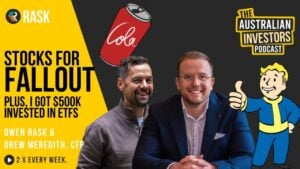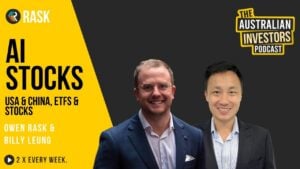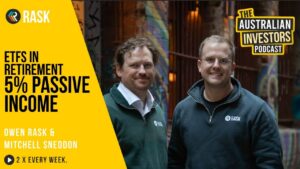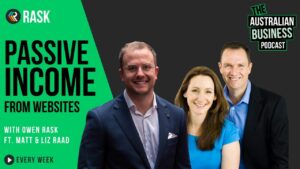In this episode of The Australian Investors Podcast analyst Owen Rask and Wattle Partners financial adviser Drew Meredith, CFP discuss how to analyse a fund manager.
Using Drew’s experience as a financial adviser and Owen’s experience interviewing fund managers and time spent being a fund analyst, the duo breaks down what it takes to analyse a fund manager before investing.
The Australian Investors Podcast is one of Australia’s top investor podcasts, as ranked by Apple Podcasts & Spotify, focused on investing in ASX & global markets.
Invest. better. With The Australian Investors Podcast. Subscribe on Apple.
When you subscribe to the podcast on Apple Podcasts, Spotify, YouTube or Castbox you’ll get weekly insights on ASX & global shares, funds, ETFs and more. Let Owen be your field guide to investing profitably for decades to come.
Show notes
In this episode, Owen and Drew break down what it takes to analyse a fund manager before investing.
Topics discussed in this Australian Investors Podcast episode include:
- Is active funds management worth it, why?
- How do you measure the effectiveness of a fund?
- Tracking error is good for passive funds. For example, if a fund or ETF tracks the ASX 200 (ASX: XJO) the tracking error would tell you ‘how well has the fund followed the ASX 200’. For an active fund manager, the active share metric measures ‘how different is the fund’s positions compared to the index’? Obviously, for active fund managers it’s important they are more active and less passive (i.e. less closely matching the index).
- Low downside capture, higher upside capture. ‘Capture’ refers to how the return of a fund matches the return of the market. For example, if a fund returned 10% when the market went up 20%, the upside capture would be 50% (or 0.5). If the market fell 20% but the fund returned 1% (positive), its downside capture would be very low. Meaning, it doesn’t ‘follow’ the market down — which is a good thing.
- Correlation. Correlation measures how two investments behave around each other. For example, if there is a correlation of +1.0 between an Australian shares fund and your portfolio, we would say it does not have any risk benefits for the portfolio (because they’re both positively and perfectly correlated — meaning they move in the same direction at the same time). Gold prices can have a low or negative correlation to shares/equities, meaning they can move in opposite directions — so it could help lower the impact of a stock market crash.
- Sector diversification. Basically, how well are you diversified and how well is the fund or ETF diversified?
- “Style drift” and understanding why your fund manager has changed their strategy or focus. Do they do what they say and has that changed?
Are some parts of a portfolio better reserved for active funds management?
- This really depends on the underlying index, as that is essentially what you are getting. Fixed income, in this environment, should be active, but if interest rates were at 7 per cent, I — Drew — would be passive all the way.
- For US equities the S&P 500 is 30 per cent invested in just five companies, so a combination of active and passive is likely warranted, just to gain real diversification into more parts of the market.
When you study fund managers, Drew, is it top-down or bottom-up?
- Usually, we are looking at fund managers for a purpose, so it’s ‘top down’ (e.g. ‘we need some Australian shares for this client’)
- We think about it in terms of factor exposure, meaning how is the portfolio exposed value, income, size, and momentum (the four quantitative factors).
- Then, which factors are likely to perform better during the current market and what are we missing? We then go through the due diligence, getting a universe of options, before considering.
Do you always meet with funds before investing?
Drew say yes, meeting the portfolio manager twice is a minimum, and thankfully that’s much easier with Zoom. Also, it’s important he looks at the entire portfolio.
What are the 3-5 questions you ask all the time?
- For equities, what is your tracking error?
- What is your upside & downside capture?
- Do you have any risk management processes?
- How are you reducing key person risk?
- What level of institutional capital do you have? Too much institutional capital is a bad thing for smaller investors for tax and volatility reasons.
What are the 3 documents or resources you use to research fundies?
- DD checklist
- Research house reports
- Financial Services Questionnaire
What are some of the common reasons you remove a fund from a client portfolio?
- Change in our views on that factor or sector of the market
- Change in manager
- Style drift, away from what we expected
- Sustained underperformance (e.g. 2 or 3 years of bad performance)
- Misalignment
Date of recording: January 25nd, 2022
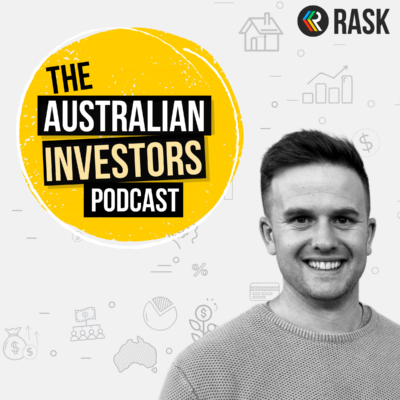

 this episode, you’ll LOVE our series. Episodes go live every Saturday at 7 am and Wednesday arvo.
this episode, you’ll LOVE our series. Episodes go live every Saturday at 7 am and Wednesday arvo.


